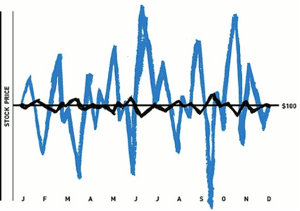Alan Ellman, of TheBlueCollarInvestor.com highlights the different types of volatility—historical, expected, and implied—rates each one by level of significance, and shares why, as a covered call writer and seller of cash-secured puts, he is selling volatility.
When we write covered calls or cash-secured puts, we are selling volatility. The time value component of a short-term option premium reflects the amount of time until expiration plus the volatility of the underlying security. Since most of us are comparing options with similar expirations, the volatility of the stock or exchange-traded fund represents the distinguishing factor in our option sales. In this article, we will review all aspects of volatility and bring this information into our world of option-selling.
What Is Volatility?
Volatility represents the price movement of the underlying security with no predilection to direction. It is an annualized statistic quantified as one standard deviation price change. This tells us that the statistic is projected to be accurate 68% of the time. This means that if a $60.00 stock has a volatility of 25%, it is expected to fall in the price range of $45.00 to $75.00 over one year 68% of the time. Two stocks that start and end with the same price over a one-year time frame can have very different volatilities as shown in the chart below:
Comparing Volatility of Two Stocks
Although both securities started and ended the year at $100.00, the blue stock has much greater volatility and will generate higher option premiums at the expense of being a riskier underlying security. Each investor must determine the amount of volatility appropriate for their personal risk tolerance. For me, I have a goal of 2 -4% for a near-the-money one month expiration. In bull markets, I’ll go a bit higher. The question we should ask ourselves is “how much volatility should I sell?”
Types of Volatility
- Historical volatility: The actual price fluctuation as observed over a period of time, usually one year.
- Expected volatility: This is a prediction of future price movement in either direction and is totally subjective. This is the least significant of the three types of volatility.
- Implied volatility: This is a prediction of the underlying security’s future price movement based on the option’s price in the marketplace. For short-term option-sellers, this is the most significant of the three types of volatility. An event like an upcoming earnings report can render the implied volatility much higher than the security’s historical volatility.
Impact of Volatility on Our Option Premiums
An increase in volatility will increase the value of both call and put options and a decrease in volatility will cause a decline in both call and put premiums.
The Role of Vega
Vega is the amount an option price will change given a 1% change in implied volatility. Let’s say that company BCI has an option value of $4.00 and a Vega of 0.06. The current value of one contract is $400.00. If the implied volatility increases by 1%, the option value for the contract will be $406.00. If the implied volatility decreases by 2%, the value of the contract will become $388.00, all other factors remaining the same.
- Impact of Vega and the moneyness of options (for every 1% change in volatility)
- In-the-money options: Have the least amount of time value and therefore the smallest dollar and percentage changes.
- At-the-money options: Have the greatest time value and the largest dollar changes.
- Out-of-the-money options: These are all time value and therefore the highest percentage changes.
Discussion on Incorporating Volatility Into Our Option-selling Strategies
As covered call writers and sellers of cash-secured puts, we are selling volatility. For our short-term positions, implied volatility is the most significant of the three types of volatility because it reflects the current market assessment of future price movement of our underlying security. A great starting point for incorporating volatility into our trading decisions is to set return goals based on personal risk tolerance. A conservative starting point may be 2-4% per month for near-the-money strikes. Extremely high or low implied volatilities will not meet this standard. Goals can be tweaked based on your objectives and risk tolerance. Once size does not fit all.
By Alan Ellman of TheBlueCollarInvestor.com






















